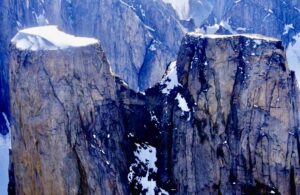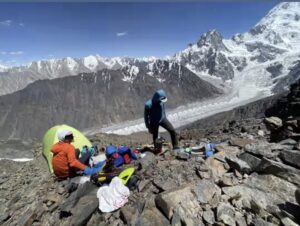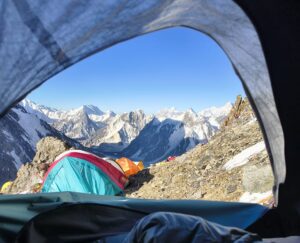There is little shelter on the huge faces of the world’s best big-wall climbs. When you finish a section, another one might appear that you had not imagined. You may have seen a photo from a previous climb and be perplexed when you reach the foot of the wall and the reality looks totally different.
In the Karakoram, above 6,000m, you must take on freezing temperatures, a lack of oxygen, avalanches, wind, and storms. Big-wall climbing tests your knowledge, your skills, your assertiveness, and your mental strength.
This article looks back at the first big-wall climbers to take on Great Trango Tower, culminating with John Middendorf and Xaver Bongard’s epic 1992 route, The Grand Voyage.

An avalanche rushes down the mountain.
The first ascent of Great Trango Tower
Great Trango Tower, part of the Trango Towers, lies north of the Baltoro Glacier in the Baltoro Muztagh subrange of the Karakoram. Great Trango has four summits: central (the main summit), east, west, and south. All exceed 6,200m. The towers offer some of the most difficult big-wall climbing in the world.
The 6,286m central summit was first climbed on July 21, 1977. American climbers Kim Schmitz, Galen Rowell, John Roskelley, Dennis Hennek, and James Morrissey ascended a route that started on the west side and ended at the top of the south face.

Kim Schmitz hams it up at Great Trango Tower Base Camp in 1977. Photo: Galen Rowell, Kim Schmitz Collection
Galen Rowell, always searching
Rowell was best known as an incredible mountain photographer but he was also a great climber. In his book Mountain Light, he wrote that he might never have made the first ascent of Great Trango had it not been for a photo he took two years earlier. In 1975, while on the approach trek to K2, he awoke to see the Trango Towers, brilliantly lit by the morning sun.
“Dawn light illuminated the peaks through the exceptionally clear air that follows thunderstorms, while a Beethoven concerto played on a stereo. Without even getting out of the bag, I shot image after image of the snow-rimmed towers and spurs, all of them still unclimbed,” he wrote.

Galen Rowell on the job. Photo: Galen Rowell
The north pillar to the east summit
In the summer of 1984, a Norwegian team made the first ascent via the north pillar to the east summit (6,231m). Their route took them up the most impressive and striking vertical buttress of the whole massif and was quite the mountaineering feat. Unfortunately, their climb was not all smooth sailing.
Hans Christian Doseth, Stein P. Aasheim, Dag Kolsrud, and Finn Daehlie saw a photo of the impressive wall in a 1983 edition of Mountain Magazine. “Like many other projects…the idea was conceived at home in the living room,” Kolsrud wrote.

Norwegian climber Hans Christian Doseth. Photo: Stein P. Aasheim
When the Norwegians arrived, they set up their base camp in a small, flat, sandy hollow between moraine ridges and the mountainside.
They didn’t know much about the pillar beforehand. They only had three or four photos taken from the Baltoro, in which only the upper part of the wall was visible. The massive lower section is only visible once you hike onto the Dunge Glacier.
The Norwegians were amazed at the unbelievably elegant line, a beautiful initial buttress more than 900m high leading to a headwall of more than 600m.

Map of the Trango Towers and the three glaciers around them — the Trango Glacier, the Dunge Glacier, and the Baltoro Glacier. Photo: Jan Kielkowski
Pushing the vertical limit
Rated A4, the wall pushed them to their limit. The four Norwegians took a long time to overcome the lower part of the wall because of bad weather and the weight of their gear. But they knew that the greatest challenge would be the 500m still to come.

The Norwegian route of no return. Photo: Sebastian Alvaro
They were now low on food, and there was still a long way to climb. Kolsrud suggested that two of the four go down (completing only 90% of the route), while the other two push on.
But at first, no one wanted to leave. For a couple of days, they discussed the issue. While they debated, they advanced further up the route. Finally, they came to a point where the crack they were climbing opened to an off-width of such difficulty that, because of a lack of protection and general exhaustion, it was impossible to free climb.
They knew that this was the moment to make a decision. Daelhie and Doseth would continue to the summit, Kolsrud and Aasheim would head down.
Five days after Kolsrud and Aasheim made it safely back down, they watched their companions summit through binoculars. Then, Daelhie and Doseth began to rappel the headwall before disappearing out of sight behind a shielding ridge.
Kolsrud and Aasheim thought that everything was under control, and both left Base Camp. Aasheim returned to Islamabad and Kolsrud traveled to a nearby village to run some errands.

Jan Kielkowski’s sketch of the Trango Towers. The pen indicates the route now known as No Return. Photo: Jan Kielkowski
No return
When Kolsrud returned to Base Camp, there was no sign of Daelhie and Doseth. Scouring the wall with binoculars turned up nothing. He was certain that they had suffered an accident. Three weeks later, a Pakistan Army helicopter arrived and located two lifeless bodies lying in the snow at the foot of the wall. They could not pick up their bodies because of bad weather. By the time they returned in better conditions, there was no trace of the two deceased Norwegians.
Perhaps an avalanche had ripped them from the wall, or a piece of protection came loose from its anchor, causing a fall of more than 1,500m. Since the tragedy, this route has been called No Return.
“The tragic Norwegian effort proved to be a milestone of style and commitment in big-wall climbing that paved the way for future landmarks,” American climber John Middendorf wrote in an article for the American Alpine Club.
1992 Swiss-American expedition
In the summer of 1992, a Swiss-American team decided to take on the 1,500m of smooth granite on the east face of Great Trango. Since the Norwegian tragedy, no one had been able to repeat the route, either directly, by a variant, or via a new route to the east summit.
The team consisted of Swiss climbers Xaver Bongard, Ueli Buhler, and Francois Studemann, American John Middendorf, and photographer Ace Kvale.
On June 24, 1992, the team made its base camp near the Dunge Glacier.

Trango Towers emerge from the landscape. Photo: Ace Kvale
But the group soon split. Buhler and Studemann opted to climb the Nameless Tower, while Middendorf and Bongard started planning a new route on the east face of Great Trango Tower.
Middendorf told Explorersweb that when scouting the line, they both saw the potential of the east wall. It was shorter than the 900m initial buttress of the Norwegian route, but steep and overhanging the whole way, full of emerging lines very similar to the right side of El Capitan. The overhanging wall then continued along a 200m tall summit pyramid.
Scouting the line
Middendorf, with a wealth of experience on big walls, studied the line for a week with binoculars. In between, they ferried loads up to a small camp a few hundred metres above the glacier. He felt that there was a good line there, one that only needed a few dozen rivets and bolts.
The upper headwall had two distinct lines on its buttress. The Norwegians had taken the left one, facing east. It was a smart move, as that route received more sun. But Middendorf and Bongard wanted to do something new and chose the right, north facing-line. Both of these lines are cracks on either side of a gargantuan 600m flake that leans against the upper headwall.
After 20 days of planning, it was time to begin.

The American-Swiss team in a previously unpublished photo, taken in Rawalpindi, on June 17, 1992. Back row: Ace Kvale, Ueli Buhler. Front row: Francois Studemann, John Middendorf, and Xaver Bongard. Photo: Bigwalls.net
Ali Baba’s Couloir
The approach to the base of the wall was very dangerous. The glacier was full of crevasses, and two seracs sent down avalanches of ice and snow. Above the second serac, a huge couloir that they dubbed Ali Baba’s Couloir led along the base of the east face to the start of their chosen line.
During the warmer hours of the day, the couloir was very active, full of avalanches and ice falls. So the two climbers opted to climb at night. But even in the wee hours, piles of ice and rock still cascaded down regularly.
At one point Bongard called out, “Get out of the gully now, in a minute you will die!” Subsequently, a huge avalanche came down that would have wiped Middendorf out, had he not moved. Through this minefield, they carried all their food, water, and equipment for the new route.

The huge wall of the Great Trango Tower. Photo: John Middendorf
Starting the climb
On July 13, 1992, they spent their first night on the wall. They hung in a two-man portaledge designed by Middendorf for the climb. They climbed in the purest and most committed way, with only six ropes for climbing and hauling. They moved up in capsule-style and fixed rope above each camp until they decided it was safe and timely to move each camp higher.
Many of the belays were in near-suicidal positions because of ice. Moving between their camps required all their skill, strength, and brains. Mistakes didn’t bear thinking about. They also had to ration the water they had, at least until they could reach the upper part of the wall where they could collect snow to melt.
Dehydration is very dangerous in the mountains. If a climber runs out of water, they get tired quickly and struggle to think clearly. Making mistakes becomes much more likely. “It was a full-time job melting snow,” Middendorf recalled.
They named the most hazardous section of the climb “Gollum’s Gully”, a 150m long corner with a lot of avalanche danger. A few small avalanches struck Bongard and Middendorf at various spots on the wall. They also saw some massive ones not too far away. This hazardous section began to the left of the Norwegian route. Halfway up, at the top of the snow ledge, they climbed along the Norwegian route for three rope lengths. Then they continued to the right, to the summit.

John Middendorf in a portaledge. Photo: John Middendorf /Bigwalls.net
A storm around a portaledge
On July 25, a big storm trapped them for three days. On the one hand, Middendorf and Bongard were grateful for a break. Water was easy to make, as their ledge was covered with ice and slush. They still had fuel for five days, so they were not worried.
The wind buffeted the portaledge, which flexed but held up. It is almost impossible to prevent a portaledge from moving during a storm, let alone at 6,000m in the Karakoram on an exposed wall. The loss of any essential piece of gear, whether a glove or a boot, could have spelled the end of the climb, or even death.
Middendorf told Explorersweb that every day he reckoned that there was a good chance something really bad could happen. That it could be “lights out” at any moment. But they stayed busy and determined. It was a lot of hard work, long 16-hour days. They never felt recovered, but part of the strategy of big-wall climbing at altitude is to keep a good pace and deal with the challenges as they arise. “You don’t have much time to get scared,” Middendorf explained.
The second ascent of the east summit
Bongard and Middendorf summited on July 28, 1992. There was a final pitch of mixed ice and rock, then a short snow walk to the summit. They found one of the Norwegian’s pitons that had been used for rappelling. This proved that the Norwegians had also topped out on the east summit of Great Trango.
Middendorf recalls that the most important thing was that they both had fun. “On a steep wall, there is a lot of opportunity for monkeying around. We were both pretty proud to show each other our work on lead while the second cleaned the pitches. But mostly, we were just aligned with a goal of climbing that wall with as little impact as possible, with minimum drilled holes, and as efficiently as possible.”
Bongard and Middendorf became the first climbers to return from the east summit alive.

John Middendorf (left) and Xaver Bongard after their new route, The Grand Voyage, on the east summit of Great Trango Tower. Photo: John Middendorf/Xaver Bongard
The finished route
On the summit, “the first thought that came into my mind was ‘What a view!’ Then ‘How the hell are we going to get off this mountain?’ The overwhelming feeling is very transitory and probably cannot be fully remembered except in spirit,” Middendorf recalled.
Their route, parallel to the Norwegian route, consisted of technical aid climbing, some pitches of free climbing, vertical ice climbing, and rotten aid and free climbing. They needed 44 rappels and three days to complete the section they named Gollum’s Gully, all the while avoiding constant avalanches.
They named their route The Grand Voyage, Grade VII, 5.10, A4+, WI3. They climbed 1,340m from the base to the summit, in 33 pitches, with a 60m lead rope.

One of the climbers on the Grand Voyage route on Great Trango Tower. Photo: John Middendorf
John Middendorf still designs climbing gear for big walls and is active in climbing gear research on Bigwallgear.com.
Xaver Bongard died on April 15, 1994, during a 300m BASE jump near his hometown of Interlaken. Jumping from his favorite cliff, both his main and reserve parachutes failed.
“I miss him all the time. He was an amazing individual, his wild sense of fun was contagious,” Middendorf said of his friend.






